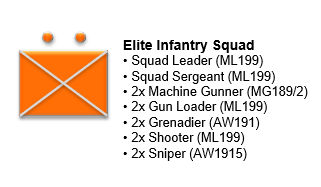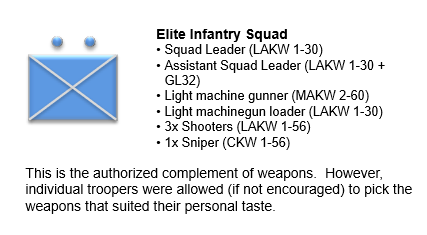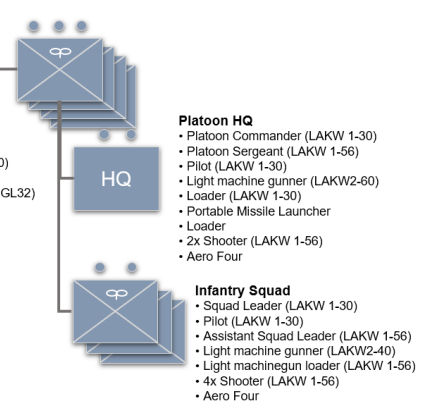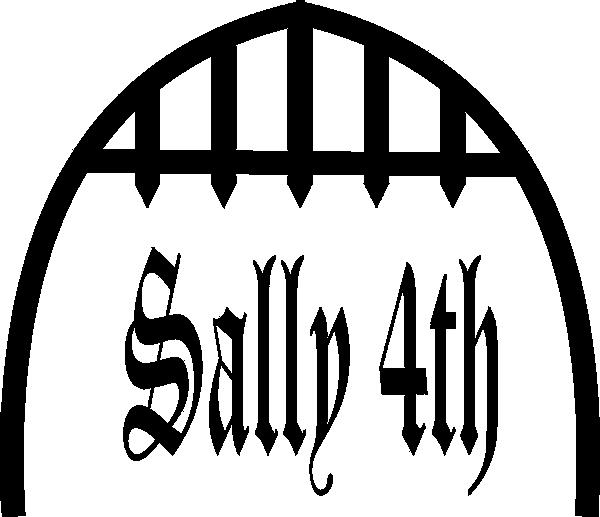
Happy Monday, dear reader!
As presaged last week, today we’re taking a look at Special Forces in ACP, how they are structured and how they work in gameplay.
It is fair to say that the idea for even including Special Forces in Albedo Combat Patrol came from Chase Murphy. He suggested the idea of Blue Wind – the ILR’s SF team, and it was incorporated in the sourcebook, becoming Canon in the process. It followed, therefore that the EDF would have a counterpart, and HomeGuard forces might well do the same.
What are Special Forces?
Well, Oxford defines them as: “The units of a country’s armed forces that undertake covert, counterterrorist, and other specialized operations.” Which is a useful definition. In the context of our modern military, these forces evolved from the Trench Raiders of World War 1. They became formalised during World War 2 by the creation of the Special Air Service, Commandos, OSS/SOE, Rangers, Brandenburgers and the like. In the absence of a truly global conflict, these units have become much more specialised so that they fit the definition much more closely. Modern equivalents would include the SAS, GSG9, US Army Rangers, SEAL Teams, Spetsnaz and many more. Police forces increasingly have special operations – think of SWAT teams.
So, in a military sense, Special Forces are employed in a variety of ways. These can include:
- Deep reconnaissance – probing far behind enemy lines to find targets for the main force. Think Long Range Desert Group.
- Raiding – blowing up targets when discovered by reconnaissance. (See above)
- Quickly neutralising key targets – these might be an enemy headquarters – like the attempt on Rommel or a coup de main like Pegasus Bridge.
- Anti-terror operations
- Hostage rescues – like Prince’s Gate
- Training insurgents or militias.
I’ve used British military examples, but there are many to choose from in all these categories. Some of them are frankly dubious – like the Rainbow Warrior incident – you could easily argue that one side’s special operations team are terrorists to the enemy.
Defining Characteristics
Because of the ways in which they are employed – typically far from home or for a short and specific purpost, the defining characteristics of Special Forces are:
- Highly Trained – all members are treated as “Elite” for our purposes
- Organisation and weaponry diverges from the norm
- Light on vehicles, support weapons and boots on the ground.
Let’s have a look at some example forces in ACP164.
BLUE WIND
In the Albedo Universe, the ILR are pioneers of special forces. Operation BLUE WIND sent forces far ahead of the ILR zone of control to find targets of opportunity, carry out raids and establish covert bases as a precursor to invasion. They are a wartime force, according to canon, but rumors persist that their legacy lives on in the post-war ILR military.
In the upcoming “Rumble in the Jungle” campaign, a Blue Wind force is the backbone of the ILR faction – having established a secret base and created an insurgency – which they are training.
As you will have seen from the image above, the Blue Wind team contains 12 critters. Two fire teams form the squad, each centred on a LMG group, and heavy on portable support – grenade launchers and snipers. All the members are elite, and the squad carries demolition charges and grenades in addition to their weapons. You can buy a pack for the whole team from the Sally 4th Web store.

SOFT
The EDF didn’t adopt special forces until Phase IV of the war. When I wrote the history, I thought that there was probably a faction within the EDF military which held that all EDF troopers were Elite – eventually they were overruled when the ILR success in this space became obvious. As a result, the EDF Special Operations Force Team (SOFT) is more than an ironic acronym.
Again, in my mind, the SOFT has much more in common with the early SAS than anything else. Where the EDF tends to be quite uniform in their way of doing things, SOFT is a lot more laissez-faire while remaining elite. While the figure below contains the ‘book’ organisation, you can be a lot more relaxed about building this squad.

As an aid to this, there is no SOFT pack available for you to buy. You can really make the squad up using whatever miniatures you have to hand, within the bounds of reasonability. This leads me to the issue of game balance and points costing – which is really too complex for this post. I might deal with that in a later issue. Suffice it to say that minor variety in weapons doesn’t make much difference to the Squad Combat Value, but giving every critter an LMG would. Be reasonable.
HomeGuard
Way back in the HomeGuard posting we noted that HG units are pretty much whatever you want them to be. This principle extends to special forces, which should really be a more elite, better armed version of your normal force. Because I still want you to buy the Almata Campaign Book, I’ll suggest loooking at Q company, which is the AHG’s elite force.
Q company is an example of a postwar unit that is much more heavily geared to counter-terrorism than long range reconnaissance. In practical terms, they are ‘tooled up’.

Because they are part of a regular airborne infantry formation, they have a full complement of vehicles and support weapons in the depot, as well as a distinctive all-black uniform and gas mask combo. Again, there is no Q company pack available, but you can easily make up this squad using light infantry EDF miniatures and the beret or gas mask head as you see fit.
Employment in the game
There are two basic ways to employ SF units in ACP164. The first of these is as a ‘stiffener’ for a regular or militia force. In real life, SF troopers hate this idea, because it puts them into the leg infantry role and reduces their ability to be tactical and employ their special skills. The forthcoming “Rumble in the Jungle” book will allow you to play with the reality of these restrictions and see for yourself.
History gives us plenty of examples of SF detachments performing heroically while supporting militias. You might like to explore the exploits of the Australian Army Training Team in Vietnam, which was awarded three VC medals. (Example WOFF Ray Simpson)
The other approach is to create smaller scenarios involving special missions. I prefer to play these scenarious in ‘heroic’ CP mode, where each figure is treated as a unit. In the next episode, I will discuss how to set these up in more detail.
Until then, happy gaming!

0 Comments